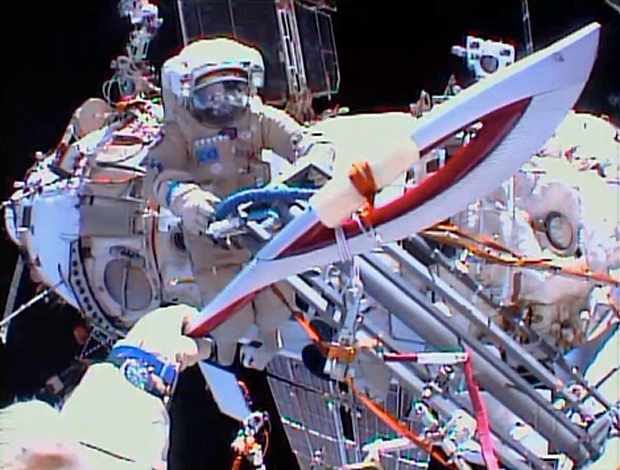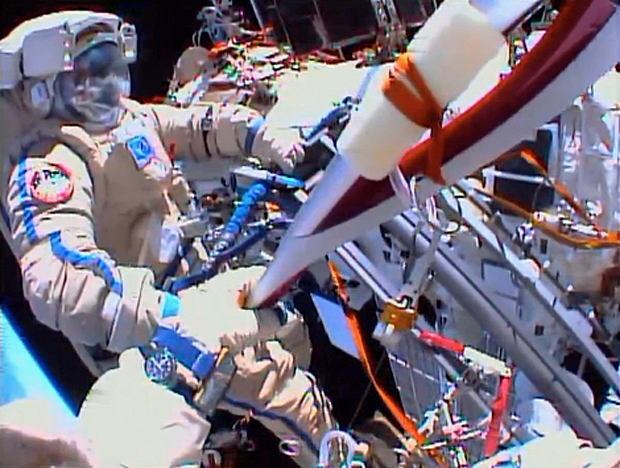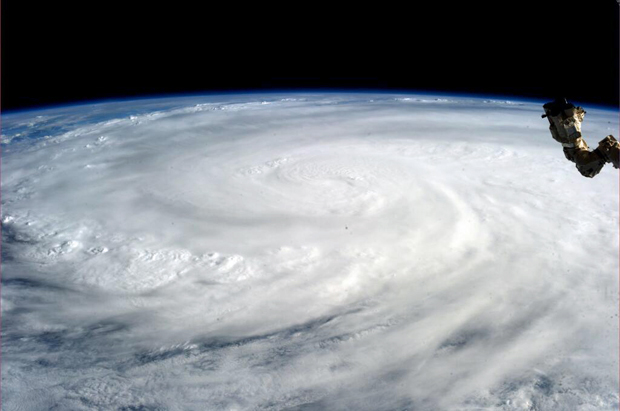Realtime coverage of Russian EVA 36
11/09/2013 03:38 PM Filed in: Space News | International Space Station
By WILLIAM HARWOOD
CBS News
03:35 PM EST, 11/09/13: Spacewalk ends
Cosmonauts Oleg Kotov and Sergey Ryazanskiy returned to the safety of the Pirs airlock module Saturday to close out a five-hour 50-minute spacewalk highlighted by a symbolic Olympic torch photo op.
The cosmonauts began repressurizing Pirs at 3:24 p.m., ending the year's eighth space station assembly and maintenance spacewalk.
Kotov and Ryazanskiy accomplished their major objectives, spending just under two hours on the Olympic relay publicity shoot and working on a camera mounting platform that will be used later by a Canadian company to beam down high-definition Earth views.
But the cosmonauts were unable to install a foot restraint as originally planned, bringing it back inside the station for troubleshooting, and they could not fold down an antenna on a deactivated seismic experiment.
This was the 174th station spacewalk since assembly began in 1998, the fourth for Kotov and the first for Ryazanskiy. One hundred and 13 astronauts, cosmonauts and international spacewalkers have now logged 1,094 hours and 39 minutes of station EVA time, or 45.6 days.
11:45 AM EST, 11/09/13: Olympic torch handed off in symbolic spacewalk relay
The Olympic torch relay leading to the 2014 Winter Games in Sochi, Russia, chalked up a space first Saturday, with two cosmonauts staging a symbolic handoff, passing the torch back and forth while posing for publicity shots during a six-hour spacewalk.
Cosmonaut Sergey Ryazanskiy floated out of the Pirs airlock first, carrying commercial Go-Pro cameras and other gear to record proprietary video of the torch for Olympic organizers in Russia.
Fellow spacewalker Oleg Kotov held the safely tethered torch in the open hatch of the Pirs module while Ryazanskiy took pictures and mounted cameras on station structure to record the scene. Kotov then floated outside and made his way to the ladder where he met up with his crewmate.
"Here we go, wave and smile," Russian flight controllers radioed a few minutes later.
Both cosmonauts then posed for the cameras and Kotov handed the torch off to Ryazanskiy. They then repositioned themselves and carried out another handoff with more posing for still photos and video. While some of the photography was proprietary, views from NASA helmet cameras and others mounted on the exterior of the station provided realtime views.
"The weather is beautiful, we'll just take a stroll," one of the cosmonauts said as they moved to a different location. Both men took a break during a night pass, resting and enjoying the view from 250 miles up.
"Are you hiding from us?" a flight controller joked at one point.
"We are taking a nap," one of the cosmonauts replied.
The torch then was carried to yet another location for additional handoffs and more pictures before it eventually was returned to the airlock and safely stowed away inside.
"Olympic torch operations are now complete," one of the cosmonauts radioed just under two hours into the spacewalk.
If all goes well, the torch will be returned to Earth Sunday aboard the Soyuz TMA-09M spacecraft that will bring Fyodor Yurchikhin, Luca Parmitano and Karen Nyberg back to Earth to wrap up a 166-day stay in space.
Nyberg posted a dramatic view of Typhoon Haiyan early Saturday, showing the massive storm, stretching from horizon to horizon, shortly after it passed over the Philippines.
The torch relay on Earth is expected to take 123 days, involve some 14,000 people and cover 34,800 miles across Russia, not counting the mileage chalked up aboard the space station.
This was the second space flight for an Olympic torch. The shuttle Atlantis carried a torch aloft in 1996 before the Summer Games in Atlanta, but it was not taken outside.
09:40 AM EST, 11/09/13: Russian EVA-36 begns
Cosmonauts Oleg Kotov and Sergey Ryazanskiy opened the hatch of the International Space Station's Pirs airlock module at 9:34 a.m. EST (GMT-5) Saturday to officially kick off a planned six-hour spacewalk.
The excursion is highlighted by a symbolic, high-profile Olympic torch handoff in orbit to herald the 2014 Winter Games in Sochi, Russia.
The cosmonauts also plan to carry out routine maintenance and assembly tasks, moving a foot restraint for an upcoming spacewalk, stowing an experiment package and finishing work on a camera aiming platform that a Canadian company will use later to stream high definition Earth views to subscribers around the world.
This is the 174th spacewalk devoted to station assembly and maintenance since construction began in 1998, the eighth so far this year, the fourth for Kotov and the first for Ryazanskiy. Going into today's excursion, 112 astronauts and cosmonauts had logged 1,088 hours and 49 minutes of spacewalk time on the station, or 45.4 days.
For identification, Kotov, call sign EV-1, is wearing a Russian Orlan suit with red stripes. Ryazanskiy, EV-2, is wearing a suit with blue trim.
The first item on the agenda is the Olympic torch photo op. Ryazanskiy planned to exit the airlock first, using still and video cameras to capture proprietary footage of Kotov, with the safely tethered torch, posing in the Pirs hatch.
After mounting cameras on the station's hull, Ryazanskiy will join Kotov for a symbolic torch handoff in space. A variety of shots are planned before the torch is returned to Pirs. The cosmonauts then will press on with other tasks on their EVA timeline.
As with all spacewalks on the station, the crew members inside will be isolated in parts of the lab complex where they will have access to the Soyuz ferry craft that carried them into orbit.
The Soyuz TMA-09M crew -- Fyodor Yurchikhin, Luca Parmitano and Karen Nyberg -- will spend the day in the Russian Zvezda command module where their ferry craft is docked.
The Soyuz TMA-11M crew, launched earlier this week -- commander Mikhail Tyurin, Rick Mastracchio and Koichi Wakata -- will be restricted to the forward segment of the station with access to the Russian Rassvet module where their Soyuz is attached.
Kotov, Ryazanskiy and Michael Hopkins make up the Soyuz TMA-10M crew. While Kotov and Ryazanskiy are outside, Hopkins will be isolated in the Poisk module where the TMA-10M craft is docked.
CBS News
03:35 PM EST, 11/09/13: Spacewalk ends
Cosmonauts Oleg Kotov and Sergey Ryazanskiy returned to the safety of the Pirs airlock module Saturday to close out a five-hour 50-minute spacewalk highlighted by a symbolic Olympic torch photo op.
The cosmonauts began repressurizing Pirs at 3:24 p.m., ending the year's eighth space station assembly and maintenance spacewalk.
Kotov and Ryazanskiy accomplished their major objectives, spending just under two hours on the Olympic relay publicity shoot and working on a camera mounting platform that will be used later by a Canadian company to beam down high-definition Earth views.
But the cosmonauts were unable to install a foot restraint as originally planned, bringing it back inside the station for troubleshooting, and they could not fold down an antenna on a deactivated seismic experiment.
This was the 174th station spacewalk since assembly began in 1998, the fourth for Kotov and the first for Ryazanskiy. One hundred and 13 astronauts, cosmonauts and international spacewalkers have now logged 1,094 hours and 39 minutes of station EVA time, or 45.6 days.
11:45 AM EST, 11/09/13: Olympic torch handed off in symbolic spacewalk relay
The Olympic torch relay leading to the 2014 Winter Games in Sochi, Russia, chalked up a space first Saturday, with two cosmonauts staging a symbolic handoff, passing the torch back and forth while posing for publicity shots during a six-hour spacewalk.
Cosmonaut Sergey Ryazanskiy floated out of the Pirs airlock first, carrying commercial Go-Pro cameras and other gear to record proprietary video of the torch for Olympic organizers in Russia.
Fellow spacewalker Oleg Kotov held the safely tethered torch in the open hatch of the Pirs module while Ryazanskiy took pictures and mounted cameras on station structure to record the scene. Kotov then floated outside and made his way to the ladder where he met up with his crewmate.
 |
| Cosmonaut Oleg Kotov holds an Olympic torch out to fellow spacewalker Sergey Ryazanskiy during a symbolic handoff outside the International Space Station. (Credit: NASA TV) |
 |
| Ryazanskiy takes the torch and passes it back to Kotov. (Credit: NASA TV) |
"Here we go, wave and smile," Russian flight controllers radioed a few minutes later.
Both cosmonauts then posed for the cameras and Kotov handed the torch off to Ryazanskiy. They then repositioned themselves and carried out another handoff with more posing for still photos and video. While some of the photography was proprietary, views from NASA helmet cameras and others mounted on the exterior of the station provided realtime views.
"The weather is beautiful, we'll just take a stroll," one of the cosmonauts said as they moved to a different location. Both men took a break during a night pass, resting and enjoying the view from 250 miles up.
"Are you hiding from us?" a flight controller joked at one point.
"We are taking a nap," one of the cosmonauts replied.
The torch then was carried to yet another location for additional handoffs and more pictures before it eventually was returned to the airlock and safely stowed away inside.
"Olympic torch operations are now complete," one of the cosmonauts radioed just under two hours into the spacewalk.
If all goes well, the torch will be returned to Earth Sunday aboard the Soyuz TMA-09M spacecraft that will bring Fyodor Yurchikhin, Luca Parmitano and Karen Nyberg back to Earth to wrap up a 166-day stay in space.
 |
| A dramatic view of Typhoon Halyan taken by station astronaut Karen Nyberg early Saturday. (Credit: NASA) |
Nyberg posted a dramatic view of Typhoon Haiyan early Saturday, showing the massive storm, stretching from horizon to horizon, shortly after it passed over the Philippines.
The torch relay on Earth is expected to take 123 days, involve some 14,000 people and cover 34,800 miles across Russia, not counting the mileage chalked up aboard the space station.
This was the second space flight for an Olympic torch. The shuttle Atlantis carried a torch aloft in 1996 before the Summer Games in Atlanta, but it was not taken outside.
09:40 AM EST, 11/09/13: Russian EVA-36 begns
Cosmonauts Oleg Kotov and Sergey Ryazanskiy opened the hatch of the International Space Station's Pirs airlock module at 9:34 a.m. EST (GMT-5) Saturday to officially kick off a planned six-hour spacewalk.
The excursion is highlighted by a symbolic, high-profile Olympic torch handoff in orbit to herald the 2014 Winter Games in Sochi, Russia.
The cosmonauts also plan to carry out routine maintenance and assembly tasks, moving a foot restraint for an upcoming spacewalk, stowing an experiment package and finishing work on a camera aiming platform that a Canadian company will use later to stream high definition Earth views to subscribers around the world.
This is the 174th spacewalk devoted to station assembly and maintenance since construction began in 1998, the eighth so far this year, the fourth for Kotov and the first for Ryazanskiy. Going into today's excursion, 112 astronauts and cosmonauts had logged 1,088 hours and 49 minutes of spacewalk time on the station, or 45.4 days.
For identification, Kotov, call sign EV-1, is wearing a Russian Orlan suit with red stripes. Ryazanskiy, EV-2, is wearing a suit with blue trim.
The first item on the agenda is the Olympic torch photo op. Ryazanskiy planned to exit the airlock first, using still and video cameras to capture proprietary footage of Kotov, with the safely tethered torch, posing in the Pirs hatch.
After mounting cameras on the station's hull, Ryazanskiy will join Kotov for a symbolic torch handoff in space. A variety of shots are planned before the torch is returned to Pirs. The cosmonauts then will press on with other tasks on their EVA timeline.
As with all spacewalks on the station, the crew members inside will be isolated in parts of the lab complex where they will have access to the Soyuz ferry craft that carried them into orbit.
The Soyuz TMA-09M crew -- Fyodor Yurchikhin, Luca Parmitano and Karen Nyberg -- will spend the day in the Russian Zvezda command module where their ferry craft is docked.
The Soyuz TMA-11M crew, launched earlier this week -- commander Mikhail Tyurin, Rick Mastracchio and Koichi Wakata -- will be restricted to the forward segment of the station with access to the Russian Rassvet module where their Soyuz is attached.
Kotov, Ryazanskiy and Michael Hopkins make up the Soyuz TMA-10M crew. While Kotov and Ryazanskiy are outside, Hopkins will be isolated in the Poisk module where the TMA-10M craft is docked.